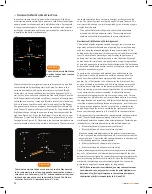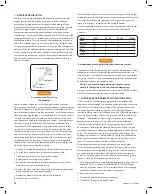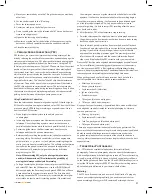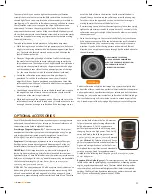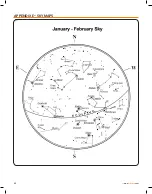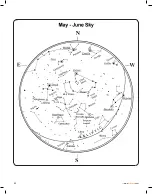
>>
www
.celestron
.com
35
Celestial pole
The imaginary projection of Earth’s rotational axis
north or south pole onto the
celestial sphere .
Celestial
An imaginary sphere surrounding the Earth,
Sphere
concentric with the Earth’s center .
Collimation
The act of putting a telescope’s optics into perfect
alignment .
D –
Declination
The angular distance of a celestial body
(DEC)
north or south of the celestial equator. It may
be said to correspond to latitude on the
surface of the Earth .
E –
Ecliptic
The projection of the Earth’s orbit on to the celestial
sphere. It may also be defined as “the apparent
yearly path of the Sun against the stars .”
Equatorial
A telescope mounting in which the instrument
mount
is set upon an axis which is parallel to the
axis of the Earth; the angle of the axis must be
equal to the observer’s latitude .
F –
Focal length
The distance between a lens (or mirror) and the point
at which the image of an object at infinity is brought
to focus . The focal length divided by the aperture of
the mirror or lens is termed the focal ratio .
G –
GoTo
Term used to refer to a computerized telescope
or to the act of slewing (moving) a computerized
telescope .
J –
Jovian Planets
Any of the four gas giant planets that are at a greater
distance form the Sun than the terrestrial planets .
K –
Kuiper Belt
A region beyond the orbit of Neptune extending
to about 1000 AU which is a source of many short
period comets .
L –
Light–Year (ly)
A light–year is the distance light traverses in a
vacuum in one year at the speed of 186,000 mi/sec.
(299,792 km/sec.) With 31,557,600 seconds in a year,
the light–year equals a distance of 5.88 trillion miles
(9.46 trillion km).
M
–
Magnitude
Magnitude is a measure of the brightness of a
celestial body . The brightest stars are assigned
magnitude 1 and those increasingly fainter from
2 down to magnitude 5 . The faintest star that can
be seen without a telescope is about magnitude 6.
Each magnitude step corresponds to a ratio of 2 .5 in
brightness . Thus a star of magnitude 1 is 2 .5 times
brighter than a star of magnitude 2, and 100 times
brighter than a magnitude 5 star . The brightest star,
Sirius, has an apparent magnitude of –1.6, the full
moon is –12.7, and the Sun’s brightness, expressed
on a magnitude scale, is –26.78. The zero point of the
apparent magnitude scale is arbitrary .
Meridian
A reference line in the sky that starts at the North
celestial pole and ends at the South celestial pole and
passes through the zenith. If you are facing South,
the meridian starts from your Southern horizon and
passes directly overhead to the North celestial pole .
Messier
A French astronomer in the late 1700s who was
primarily looking for comets . Comets are hazy
diffuse objects and so Messier cataloged objects
that were not comets to help his search . This catalog
became the Messier Catalog, M1 through M110 .
N –
Nebula
Interstellar cloud of gas and dust. Also
refers to any celestial object that has a
cloudy appearance .
North Celestial
The point in the Northern hemisphere around
Pole
which all the stars appear to rotate . This is
caused by the fact that the Earth is rotating on
an axis that passes through the North and
South celestial poles . The star Polaris lies less
than a degree from this point and is therefore
referred to as the “Pole Star” .
Nova
Although Latin for “new” it denotes a star that
suddenly becomes explosively bright at the end of its
life cycle .
O –
Open Cluster
One of the groupings of stars that are concentrated
along the plane of the Milky Way . Most have
an asymmetrical appearance and are loosely
assembled . They contain from a dozen to many
hundreds of stars .
P –
Parallax
Parallax is the difference in the apparent position
of an object against a background when viewed
by an observer from two different locations. These
positions and the actual position of the object form
a triangle from which the apex angle (the parallax)
and the distance of the object can be determined
if the length of the baseline between the observing
positions is known and the angular direction of the
object from each position at the ends of the baseline
has been measured . The traditional method in
astronomy of determining the distance to a celestial
object is to measure its parallax.
Parfocal
Refers to a group of eyepieces that all require the
same distance from the focal plane of the telescope
to be in focus . This means when you focus one
parfocal eyepiece all the other parfocal eyepieces, in
a particular line of eyepieces, will be in focus .
Parsec
The distance at which a star would show parallax
of one second of arc. It is equal to 3.26 light–years,
206,265 astronomical units, or 30,800,000,000,000
km . (Apart from the Sun, no star lies within one
parsec of us .)
Point Source
An object which cannot be resolved into an image
because it to too far away or too small is considered
a point source . A planet is far away but it can be
resolved as a disk . Most stars cannot be resolved as
disks, they are too far away .
Summary of Contents for 11007
Page 1: ...InstructionManual 11007 11008 11009...
Page 2: ...www celestron com...
Page 40: ...38 www celestron com APPENDIXD MAPSOFTIMEZONES...
Page 41: ...www celestron com 39...
Page 42: ...40 www celestron com APPENDIXE SKYMAPS...
Page 43: ...www celestron com 41...
Page 44: ...42 www celestron com...
Page 45: ...www celestron com 43...
Page 46: ...44 www celestron com...
Page 47: ...www celestron com 45...


